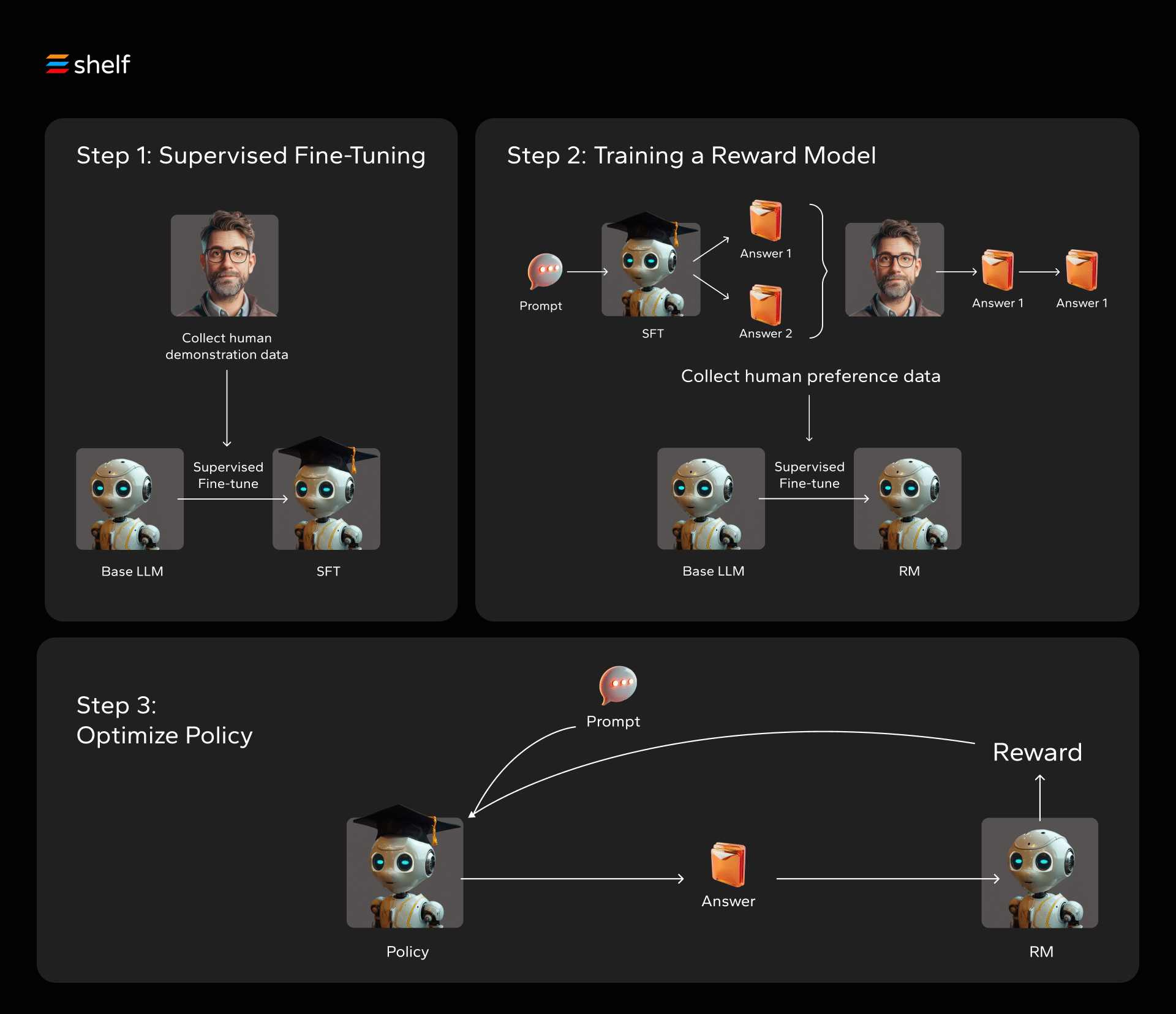Reinforcement Learning from Human Feedback (RLHF) is a cutting-edge approach in artificial intelligence (AI) that blends human intelligence with machine learning to teach computers how to perform complex tasks. This method is particularly exciting because it represents a shift from traditional ways of training AI models, making it more accessible and intuitive.
In this article, we’ll explore everything about RLHF, including the benefits, how it works, its applications and limitations, and what’s in store for the future.
What is RLHF?
Reinforcement Learning from Human Feedback is a sophisticated approach to training machine learning models by incorporating human feedback. This method is a blend of traditional reinforcement learning (RL) and human insight, where an AI learns not just from the consequences of its actions within an environment, but also from the guidance, corrections, and preferences provided by humans.
In traditional RL, an agent learns by interacting with its environment and receiving rewards or penalties based on its actions. This process can be slow and may not always capture complex human preferences or ethical considerations. RLHF addresses this by integrating human judgment into the learning process.
In practice, this means that during the training of an AI model, humans monitor the model's decisions and outcomes and provide feedback. This feedback can come in various forms, such as suggesting better actions, providing ratings on the AI's decisions, or directly modifying the rewards the AI receives. The AI uses this feedback to refine its learning, adjust its decision-making processes, and align its behavior closer to human expectations.
RLHF is particularly valuable in scenarios where defining the right or ethical action is complex and not easily quantifiable. With human feedback, AIs can be trained to perform tasks that require a nuanced understanding of human preferences, ethics, or social norms.
Why is RLHF Important?
Reinforcement Learning from Human Feedback (RLHF) is important for several reasons, particularly as it addresses key challenges and limitations in traditional AI and reinforcement learning. Here's why RLHF stands out as a crucial development in AI.
1. Aligning AI with Human Values
One of the most significant aspects of RLHF is its ability to align AI behaviors with complex human values and ethics. Traditional reinforcement learning relies on predefined reward functions, which might not capture the full spectrum of human values or the nuanced decisions we make. RLHF allows AI systems to learn from human feedback so their actions are more in line with what we consider appropriate, ethical, or desirable.
2. Improving AI Safety
RLHF can guide AI systems away from unsafe, unethical, or undesirable behaviors that might not be anticipated during the design of a reward function. This is vital in applications where AI decisions have ethical implications, such as healthcare, autonomous vehicles, or law enforcement.
3. Enhancing User Experience
AI systems trained with RLHF can better understand and adapt to user preferences, providing more personalized and satisfying interactions. RLHF can help customer service chatbots, recommendation systems, or interactive entertainment deliver responses that are more attuned to individual user needs and contexts.
4. Facilitating Complex Decision-Making
Many real-world problems involve complexities and subtleties that are difficult to encode directly into a reward function. RLHF enables AI systems to navigate these complexities by learning from examples of human decision-making.
5. Bridging Data Gaps
In situations where there is limited or no clear data on how to perform a task, RLHF allows AI systems to learn directly from human expertise. This is useful in niche domains where extensive data may not be available or in emerging fields where best practices are still being developed.
6. Advancing AI Research
Beyond practical applications, RLHF represents an exciting frontier in AI research, pushing the boundaries of what AI systems can learn and how they can interact with the human world.

How Does RLHF Work?
RLHF works by integrating human insights into the reinforcement learning process. The typical reinforcement learning setup involves an agent that learns to make decisions by interacting with its environment, receiving rewards for beneficial actions and penalties for unfavorable ones.
However, in complex scenarios where the desired outcomes are not straightforward or the nuances of human preferences need to be captured, traditional RL can fall short. This is where RLHF steps in. It guides, corrects, or augments the learning process of the AI. The process generally unfolds in several stages:
- Initial Learning: The AI begins with a baseline learning phase, often using traditional reinforcement learning methods.
- Human Intervention: Next, humans observe the AI's behavior and provide feedback. This feedback could be suggestions for better actions, corrections of the AI's mistakes, or even direct adjustments to the rewards and penalties.
- Incorporating Feedback: The AI then integrates this feedback into its learning process. This could involve adjusting its decision-making algorithm, changing how it perceives rewards and penalties, or even altering its understanding of the environment.
- Iterative Improvement: The AI goes through cycles of action, feedback, and adjustment. Over time, it learns to align its actions more closely with human preferences, thereby improving its performance.
- Evaluation and Fine-tuning: The final stages involve evaluating the AI's performance with this feedback and fine-tuning its learning processes. This ensures that the AI performs well according to standard metrics and aligns with the complex, sometimes subjective criteria of what we value.
The essence of RLHF is the synergy between human intuition and machine efficiency. Humans provide the context, values, and nuanced understanding that raw data or traditional learning algorithms might miss, while the AI offers the capability to process and learn from vast amounts of data at a scale unattainable for humans.
How does ChatGPT use RLHF?
ChatGPT uses RLHF to enhance its ability to generate responses that are not only accurate but also aligned with human preferences and values. The process involves several key steps that integrate human feedback into the model's training.
- Initially, the model is trained on a large dataset of text from books, websites, and other sources to learn language and a broad array of information. However, this training doesn't teach the model the nuances of what makes a response more helpful, accurate, or aligned with human values.
- To refine the model's responses, human trainers interact with the AI. They provide feedback on the model's outputs, guiding it towards better performance. For example, trainers might rate responses based on their relevance, coherence, safety, and alignment with what a helpful and informative response should be.
- This feedback is then used to create a reward model. Essentially, the AI learns to predict how a human would rate a given response.
- The model undergoes further training using a reinforcement learning algorithm known as Proximal Policy Optimization (PPO). PPO is a reinforcement learning algorithm that improves the stability and efficiency of policy gradient methods. It collects experiences, computes advantages and probability ratios, and updates the policy by maximizing a surrogate objective function, ensuring minimal deviation from the previous one for improved sample efficiency and stable learning.
- This allows the model to practice generating responses in a simulated environment to optimize its responses to the reward signal.
- The RLHF process is iterative. The model's performance can be continually assessed and refined with additional human feedback and training.
RLHF vs. Traditional Reinforcement Learning
RLHF and traditional reinforcement differ in their approach and utility. Traditional reinforcement learning relies on environment-derived feedback, where an AI learns through actions and their outcomes, guided by a reward function to maximize cumulative rewards. It's straightforward and effective in clear, quantifiable environments but struggles with complex, nuanced scenarios.
In contrast, RLHF incorporates human feedback, emphasizing alignment with human values and preferences, offering a nuanced learning process that's beneficial for understanding and replicating complex human behaviors. While RLHF is versatile in capturing subjective human judgments, it demands more resources and human involvement.
Essentially, traditional reinforcement learning excels in clear-cut, reward-based scenarios, whereas RLHF excels in contexts requiring a deeper understanding of human preferences and ethics, enhancing AI's interaction with humans and decision-making in complex situations.
Challenges and Limitations of RLHF
RLHF represents a significant advancement in training AI systems to perform tasks that align with human preferences and values. However, like all technologies, it has limitations.
Dependency on Quality of Human Feedback
The effectiveness of RLHF is heavily reliant on the quality and consistency of the feedback provided by humans. Inconsistent, biased, or poor-quality feedback can lead the AI to learn incorrect or undesired behaviors.
Scalability Issues
Collecting human feedback is time-consuming and labor-intensive, which can make the RLHF process less scalable compared to traditional automated reinforcement learning methods.
Complexity and Cost
Implementing RLHF involves a more complex pipeline than traditional reinforcement learning. It requires mechanisms for collecting human feedback, training models to predict human preferences, and integrating this into the reinforcement learning loop. This complexity adds to the cost.
Overfitting to Human Feedback
There's a risk that the AI system might overfit to the preferences or styles of the feedback providers, especially if the number of human reviewers is small or not diverse enough. This can limit the generalizability of the learned behaviors to broader, more diverse scenarios.
Ambiguity in Human Preferences
Human preferences can be ambiguous, conflicting, or subject to change over time. Capturing these nuances accurately is challenging and can sometimes lead the AI to receive mixed signals.
RLHF in Real-World Applications
RLHF is a powerful approach that's being integrated into real-world applications to enhance the performance and reliability of AI systems, making them more aligned with human expectations and values. Here's how RLHF is being applied across various domains.
Customer Service Chatbots
One of the more common applications of RLHF is in training chatbots for customer service. By using RLHF, companies can refine chatbot responses to be more helpful, empathetic, and contextually relevant, based on feedback from actual user interactions. This process helps improve customer satisfaction and operational efficiency by providing more accurate and human-like responses to customer inquiries.
Content Recommendation Systems
Platforms like streaming services or e-commerce websites use RLHF to fine-tune their recommendation algorithms. Human feedback helps these systems understand nuances in user preferences that are not easily captured through click-through rates or viewing history alone. This enhances the personalization and relevance of recommendations.
Autonomous Vehicles
In the development of autonomous driving systems, RLHF can be used to refine decision-making algorithms. Human feedback helps the system understand complex scenarios that are not adequately covered by simulation data alone, such as ethical considerations in split-second decision-making scenarios.
Healthcare
AI systems in healthcare (especially those involved in diagnostic processes or patient interaction) can benefit from RLHF. For instance, AI systems that assist in diagnosing diseases or recommending treatments can be fine-tuned using feedback from medical professionals to ensure that the recommendations align with human judgment and ethical standards.
Education and Training
In educational technologies, RLHF is used to develop more effective teaching tools and adaptive learning systems. Human feedback helps these systems become more responsive to the diverse learning styles, paces, and needs of students. This creates a more personalized and effective learning experience.
Gaming
In gaming, RLHF is used to develop more sophisticated and human-like non-player characters (NPCs). Feedback from players and developers helps NPCs learn more complex behaviors and interactions. This enhances the realism and engagement of the gaming experience.
Robotics
RLHF is employed in robotics to teach robots tasks that are difficult to codify with explicit programming. Through human feedback, robots can learn nuanced tasks like social interaction or complex manipulative tasks that require a level of finesse and adaptability.
Natural Language Processing (NLP)
Beyond chatbots, RLHF is extensively used in various NLP applications to improve the performance of natural language models. Whether it's summarization, translation, or content generation, human feedback is invaluable in refining these models.

What’s Next for RLHF?
The future of RLHF is poised for significant advancements, building on its current applications and addressing its existing limitations. Here’s what we expect to see for RLHF in the future.
Improved Integration of Human Feedback: We expect to see more sophisticated methods for integrating human feedback into the learning process, such as real-time feedback mechanisms, more nuanced understanding of feedback, and better ways to interpret and apply subjective human insights.
Scalability and Efficiency: Advances in RLHF may include automated ways to synthesize and generalize human feedback, reducing the dependency on human-generated data.
Enhanced Reward Modeling: We’ll see more advanced reward models that can accurately capture and predict human preferences. These models will need to handle the complexity and often contradictory nature of human feedback.
Generalization and Transfer Learning: Enhancing the ability of RLHF-trained models to generalize across different tasks and domains could involve new methods that allow models to leverage feedback from one domain to improve performance in another.
Cross-Modal Learning: Future RLHF systems may increasingly be able to learn from cross-modal feedback, such as combining textual, visual, and auditory feedback to enhance learning. This could open new avenues for more holistic and context-aware AI systems.
Explainability and Transparency: There will be a growing emphasis on making RLHF systems more explainable and transparent, enabling users to understand how human feedback influences the AI's learning process and decisions. This is crucial for building trust and for the practical deployment of RLHF in sensitive or critical applications.
Policy and Regulation: Policy and regulatory frameworks will need to evolve to address the unique challenges RLHF presents, including issues of privacy, data protection, and accountability in systems trained with human feedback.
RLHF Makes AIs More Human
It's clear that RLHF is more than just a technical advancement. It's a pivotal step towards creating AI systems that resonate with human principles and enhance our interaction with technology. It offers a pathway to more ethical, understandable, and effective AI.
The continued refinement and application of RLHF will play a crucial role in shaping AI's role in society, ensuring that our advancements proceed with a keen awareness of human values and ethics.
[/et_pb_text][/et_pb_column][/et_pb_row][/et_pb_section]



